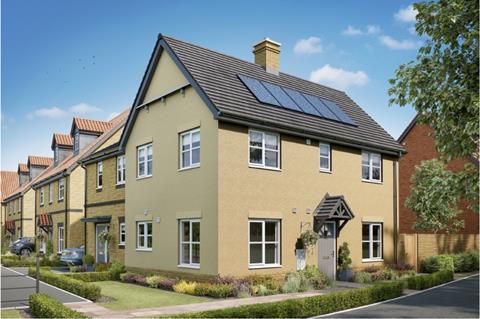Each of the houses built on a site in Suffolk will be used to trial different technologies

Taylor Wimpey is building five homes on a site in Suffolk using different energy-efficiency measures as a pilot to work out a zero carbon blueprint for its housing.
Engineers and energy experts have been working with the housebuilder to introduce what it says are “cutting-edge” green technologies in the homes in Sudbury.
All the properties will be 100% electric with triple glazing and have enhanced building fabric so that they are zero carbon ready ahead of the Future Homes Standard (FHS), which comes into force in 2025. Under FHS homes will have to produce 75% to 80% less carbon emissions than those built under the current Building Regulations.
Other technologies that will be trialled in the homes in Sudbury include Mechanical Ventilation Heat Recovery (MVHR), Waste Water Heat Recovery (WWHR), underfloor heating, ‘thermaskirt’ heated skirting boards, infrared radiant heating, sleek photovoltaic solar systems, innovative battery storage as well as air source heat pumps, heat pump cylinders, and electric panel heating.
Jennie Daly, chief executive of Taylor Wimpey, which earlier this year predicted a decline in completions in 2023, said: “The launch of our zero carbon ready homes at Sudbury marks an important milestone in helping us identify the best ways to reduce the energy intensity of our homes as well as identifying the challenges that will need to be overcome to do so at scale. This is a critical step in our journey to ensure we deliver on the UK’s net zero ambitions as well as deliver the new homes the country desperately needs.”
She added: “We are proud to be collaborating with our supply chain partners through the full lifecycle of this trial development - from concept to customer experience - to create a sustainable blueprint for delivering customer-focused, zero carbon ready homes that are deliverable at scale.”
The five homes are expected to be finished in the coming weeks and their energy efficiency will be assessed to see which methods are most successful in achieving low carbon emissions.
An education hub is also being set up on the site to showcase the trial, explaining the low carbon technologies being used and the materials.










1 Readers' comment